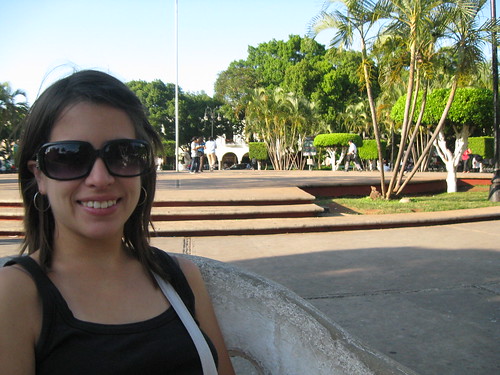
For a long time, Maru and I have wanted to visit Mérida, the capital of the state of Yucatán. We always heard nothing but great things about the city and we knew that the surrounding area was full of sights to see: infamous archaeological sites, beaches, biological reserves, incredible colonial architecture, cenotes (deep, clear sink holes), friendly people, and wonderful regional food. It is also a very different place from central and southern Mexico. Food changes, accents change, even some customs change, sort of like the difference between north and south in the US.
So, with time on our hands, we found a good package deal on a flight and hotel and took off for a week. We were not disappointed. Mérida and the Yucatán met and surpassed all of our expectations. Our days were long and full, we clocked about 900 kilometers on the rental car, and there´s even more we could have done. Here´s a small peek into our week.
Day 1
Our plane landed at about 1:30 pm, and we picked up our rental car (a very basic compact Chevy) and headed to our hotel, Casa de las Columnas. It´s in a renovated colonial building with beautiful tiles and high ceilings on the ground floor about 9 blocks from the Plaza Grande in downtown Mérida, about a 15 minute walk. Our room was spacious and clean, and we had hot water and great water pressure. Can’t ask for much more from a basic hotel room.
After settling in, we took a walk downtown in search of our first meal, sticking to the shade to avoid the intense Yucatán sun. The restaurant we decided to stop at, La Blanca Mérida, was ok. They gave us a nice little coleslaw followed by a yummy lentil soup, but then the main course took a bit of a dive as things were lukewarm rather than hot and not so fresh. What made matters worse was that Maru got eaten alive by mosquitoes, inside the air conditioned restaurant! All in all, not our best dining experience, but we were unperturbed.
We made it to the plaza, got to know the twin seats that are all over this part of the country (set up like that love toilet from an old SNL commercial spoof), walked through the Palacio Municipal, which had some really cool murals, took a look at the cathedral (a lot more stark than the elaborate one in Puebla), and got some very helpful information from a man in the tourism office. By that point, the heat had done us in for the afternoon, so we headed back to our room and rested for a bit.
We finished the day by heading back to the plaza in the evening. Mérida is full of free, public events, and every Monday night, there is a regional folk dance demonstration with a live band. As avid fans of Mexican folk dances, Maru and I have both seen quite a few folk dance groups, but this one was in a league of its own. The dancers made the whole thing look effortless and joyful (even when they were dancing with trays on their heads loaded with drinks) and the choreography was incredible. They danced for a solid hour, and then we went in search of a snack and almost immediately found our first marquesita cart. A marquesita is most easily compared to a crepe, but the way it is cooked is very different, and when it is served to you, it is very crispy, almost like a thin waffle cone. Fillings are edam cheese, nutella, cajeta, lechera or some kind of combination. I loved it with the cheese. Yummy. This marquesita would prove to be the first of about five that we ate at other points throughout the week.
Day 2: RutaPuuc and Uxmal
Between about 500 and 1400 CE, the Mayans built and expanded like crazy, and in spite of systematic cultural genocide, which included the destruction of their temples and pilfering of their cities to build churches, many Mayan buildings and sites survive to this day and have been restored for visitors by the federal and state government. We spent our second day soaking in a small but impressive sampling of this ancient history along what is known as the Puuc Route, Puuc being a particular style of construction from the period.
Originally, we had intended to start the Puuc Route in the Lol-tún caves, but you have to enter the caves with a guide and on a particular schedule, and we got a little turned around in the town of Ticul, so we lost our window of opportunity. Oh, well. It was a very miniscule damper on an otherwise amazing day.
The route consists of four minor sites and the major site of Uxmal, which rivals (and, depending on who you ask, surpasses) Chichén Itzá in size and extension. Our first stop was Labná, which gave us an introduction to these very particularly Mayan archways that we would continue to see at other sites. Next up was Xlapak, which is a site that isn’t really excavated yet, so they don’t even charge you to get in. Here, it was interesting to see more or less what these sites looked like before archaeologists took on the monumental task of cleaning and restoring the buildings. Due to time constraints, we had to skip the site known as Sayil, and we headed straight for Kabah.

You never really know what to expect when you go to an ancient archaeological site, as the pictures and descriptions often don’t do the site justice. Kabah was a case in point. At the entrance, there was a map of the site, and at first I thought it would take us hours to see everything, but the man selling tickets told us that only a small percentage is excavated. Fully excavated, the place would certainly be as impressive as any major archaeological site in the world. Just the little bit we saw was a sight to behold. Most of the grandeur is blocked from view by the layout, but as soon as you climb the first steps you are greeted by a massive wall of intricate carvings known as masks of Chaac, a principal deity of the Mayan religion, a type of rain or water god. The Yucatán is dry and hot, and due to its geological structures, there are almost no inland rivers or lakes. Instead, there are cenotes, or large, underground wells of fresh water, but the cenotes couldn’t meet all of the needs of cities full of people a thousand years ago, so they developed sophisticated ways to collect rain and devoted a lot of time and energy to worshipping the god in charge of water to keep in good standing. You know.
After Kabah, we needed to eat and we found a nice restaurant right off the main road called the Pickled Onion, just like that, in English. The owner is British, I think. The food wasn’t exactly cheap, but it was fresh and delicious. Maru had pollo pibil and I had chaya (sort of like spinach) and sundried tomato tacos. For “dessert” we made use of the pool attached to the restaurant, which was perfect to cool us off and get us ready for Uxmal.
Uxmal is incredible. We arrived at 3pm and stayed until they closed at 5pm and didn’t really have enough time to even see everything. The main pyramid itself is one of the most impressive structures I have ever seen, but there’s a whole lot more, too. Spending time at other, smaller sites earlier in the day proved to be helpful in knowing what to look for and recognizing architectural patterns in Uxmal’s buildings. Once again, Chaac was everywhere, as well as symbols of jaguars, fish, birds, turtles, iguanas, and armadillos. The details were astounding. We decided that one of these days we need an actual archaeologist to give us a tour of one of these places.
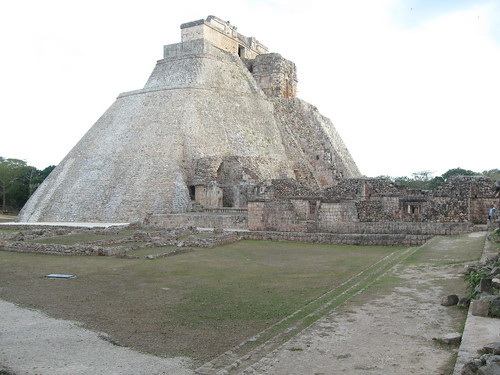
Apart from the buildings, the sites along the Puuc Route also offered small glimpses into the local natural environment. We heard and saw many different birds, and there is a species of iguana that is everywhere. In Uxmal, we actually witnessed a pair of iguanas mating! Crazy.
Once 5pm hit, we had to leave the site, but we just stepped outside for a beer as we were headed back in for the light and sound show at 7pm. We had no idea what to expect, but the price was included in the general admission, so we figured it was worth a shot. All I ever think of when I hear “light and sound show” is the laser light shows in Disney World that my dad always loved and I always thought were kind of meh. For the record, the light and sound show at Uxmal is worth it just to get the chance to enter an archaeological site at night. The place has a whole different feeling to it. As far as the actual show, the lights and music were very well designed. Everyone sat on chairs in one of the main buildings and you could see the two pyramids and the palace building, which would be lit up in different colors and patterns throughout the show. The colors and orchestration were great. The narration, on the other hand, was cheesier even then anything I’ve seen at Disney. It included “reenactments” of Mayan legends that reminded me of the historical reenactments you sometimes see in documentaries—stilted voices and absurd dialogue. Whatever, the visuals were cool.
Back in Mérida in the evening, we were hungry, so we headed to the Parque Santiago for some panuchos, salbutes, and a tamal colado, all delicious, and to top it all off, we got to see a live band and about a hundred couples dancing out in the open air, another one of Mérida’s regular, free public events. Needless to say, we got back to our room and crashed hard. That was a long day. Day 3 will be posted tomorrow!
Here is a link to our pics from Day 1, and here for Day 2.
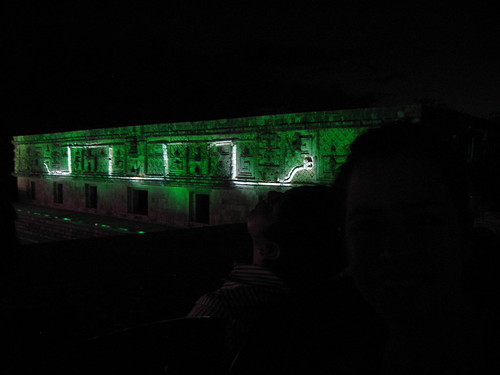
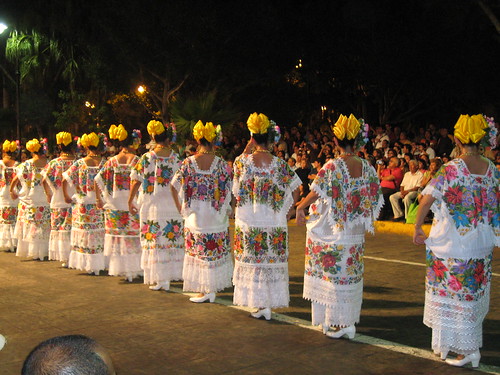
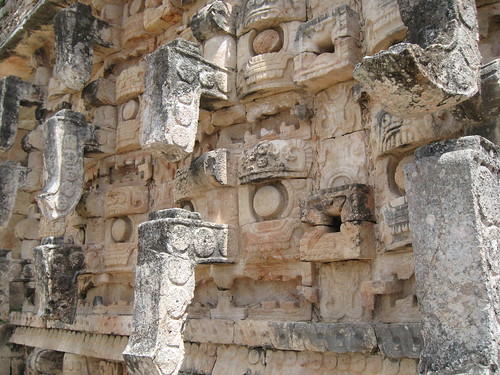

Interesting indeed...keep rocking!!!
ReplyDelete